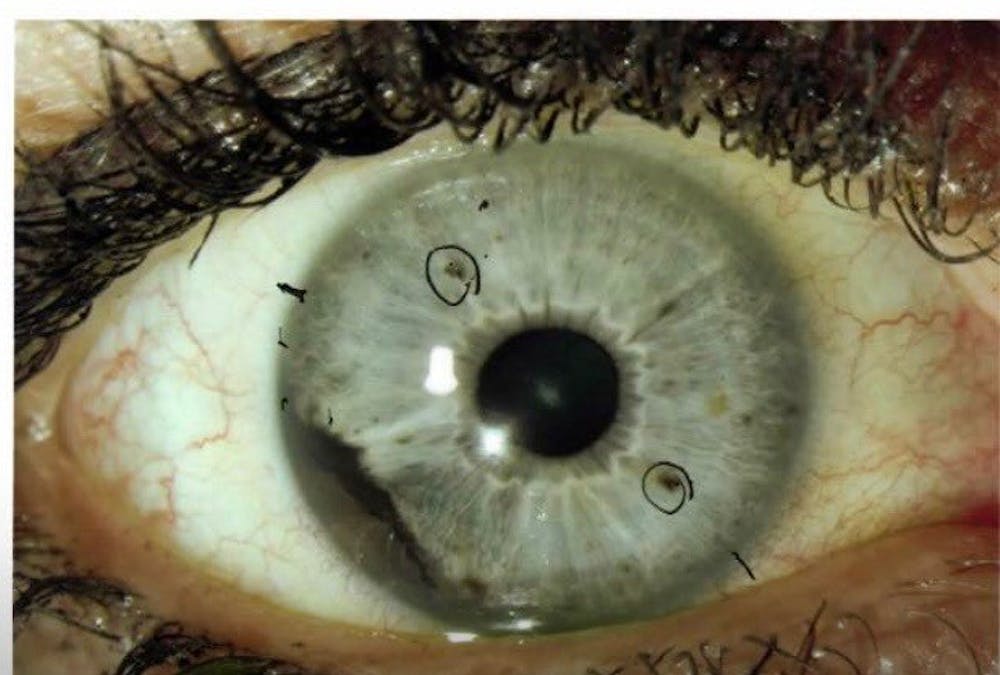A review of reported cases of ocular melanoma among former Auburn students and employees found no evidence of a cancer cluster, the Alabama Department of Public Health said Wednesday.
ADPH worked in conjunction with Auburn University to review a set of cases from 1980 through 2017. The study did not find rates of cancer higher than the number of cases that would be expected.
Concern surrounding several cases of ocular melanoma, a rare and deadly eye cancer that effects only five in 1 million people, arose after three close friends who attended Auburn at the same time — Allison Allred, Juleigh Green and Ashley McCrary — began publicizing their experience.
Ocular melanoma, sometimes referred to as uveal melanoma, is a cancer of the eye's iris, ciliary body or choroid, collectively referred to as the uvea. There is no known cause for the cancer, according to the Ocular Melanoma Foundation.
"We knew that it was going to come out this way," McCrary said in an interview with The Plainsman. "We knew before the state ever got involved that this would not be considered a traditional cluster. But we did feel like it was necessary for the state to do the analysis that they did."
In a recently released video addressing the issue, Dr. Marlana Orloff of Thomas Jefferson University — one of the medical professionals who has treated some of the survivors and has been engaged in analyzing Auburn's reported cases — said the transient college characteristics of Auburn would make it difficult for the cases in Auburn to be defined as a cluster.
"Establishing the correct number of observed cases is quite difficult," Orloff says in the video. "In Alabama, we are unsure what the denominator would be for expected cases when looking at a college campus. Again, a number of the cases were living out of state at the time of diagnosis, so they wouldn't necessarily be counted in Alabama."
The annual incidence rate in Alabama among whites, who are more likely to get the cancer, is 0.7 per 100,000. And from 2006 through 2015, there were 316 cases of ocular melanoma among Alabama residents for an average of 31.6 new cases each year.
McCrary, who has been leading a group of former Auburn students diagnosed with ocular melanoma, worked with Auburn University staff, including Medical Director Dr. Fred Kam, to provide a list of students and employees diagnosed to the department.
ADPH then reviewed the cases, gathered medical information and verified cases from the selected time period. The University then verified the attendance or employment of each person diagnosed with the cancer and provided a population file for ADPH to calculate the numbers of ocular melanoma cases that would be expected for Auburn.
ADPH conducted an analysis based on students who attended or employees who worked for Auburn University at any point from 1980 forward, ADPH said. The study included confirmed cases that were diagnosed any point between 1990 and 2017.
Only 17 people — nine males and eight females — met the criteria to be included in the report. That number is far below the number of cases McCrary and the Auburn ocular melanoma group initially provided to the University and ADPH earlier this year. The group had collected names of individuals who attended Auburn or worked at Auburn and said they had been diagnosed with the rare cancer.
Earlier this month, Kam told The Plainsman that 26 cases were verified over a 40-year span.
Not all of those cases met the date range used for the study, and others may not have been totally verified through ADPH's Statewide Cancer Registry.
Based on Alabama rates and the population file provided by Auburn University, the expected number of cases in the time frame used for the study is 8.6 for white females and 13.6 for white males, and in each instance, the expected number exceeds the number of verified cases.
A further analysis found that the ratio used to measure the observed cases compared to the expected cases was not statistically significant.
Auburn's ocular melanoma group said it was thankful for the effort on the part of Auburn and ADPH, but said the lack of a confirmed cluster would not change their course of action and would not deter the resolve of the more than 45 individuals who have self-reported their diagnosis and affiliation with Auburn.
The group, which is accepting donations for research efforts, echoed Orloff's concerns surrounding the difficulty in defining a cancer cluster.
"In addition, through this analysis we have learned it is difficult to verify cases through state cancer registries," the group said in a statement. "A number of the patients in this cohort were diagnosed out of state. The Alabama Department of Health has acknowledged that some of the patients who were reported to the state were not able to be verified due to flaws in the cancer registry systems. This is an issue we were aware of at the onset."
Diagnosing physicians are required to report diagnoses within six months to the State Cancer Registry. But if someone doesn't comply with turning the information in, the state has very limited methods to promote accountability. Other states fine physicians for not reporting incidents.
McCrary, who is now back living in Auburn, said she was diagnosed when living in Tennessee even though she went to Auburn.

Ashley McCrary, Lori Lee and Allyson Allred, who were diagnosed with ocular melanoma, attended Auburn.
When they tried to verify her case, she was not on Tennessee's state cancer registry because her diagnosis was not submitted to the state, she said.
"It is the flaw in the system that is so frustrating to people," McCrary said.
And it wasn't just her case. There were a number of cases from Georgia, in particular, that were difficult to verify because Georgia never responded to requests for verification, McCrary said.
"I hate to say it this way, but we're not putting a lot of stock in the fact that the state came back with this analysis saying it's not statistically relevant," McCrary said. "However, we still feel like it is worth pursuing the research to find out if any of us have anything in common."
An earlier analysis found that there is no cluster of ocular melanoma cases among Lee County residents, according to Auburn University.
The University has provided a full FAQ addressing questions surrounding the ocular melanoma cases.
Auburn officials previously agreed to fund the first leg of a full research study to determine if there are any potential causal factors related to Auburn among the ocular melanoma cases reported. The funding was intended to support a geospatial study.
With the new finding that there is no cluster, the University said Wednesday that it would use that funding for genetic and tissue testing instead of the geospatial analysis, based upon the recommendation of experts, and "in an ongoing effort toward finding causes and treatments with the hope of developing a cure."
"Although the State has determined that no cluster exists in Auburn, we are committed to partnering with the scientific and medical community in research," the University said in a statement. "Auburn will partner with leading ocular melanoma experts to facilitate genetic and tissue testing based on the experts’ recommendation that such research is the best method toward identifying the cause or causes of uveal melanoma and possible treatment or cure. More details will follow as to any future testing as future steps are determined."
Do you like this story? The Plainsman doesn't accept money from tuition or student fees, and we don't charge a subscription fee. But you can donate to support The Plainsman.





